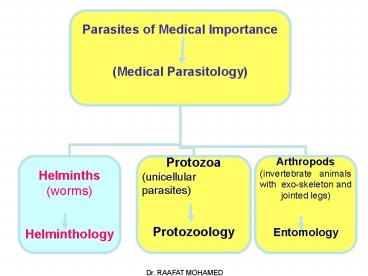Protozoa - PowerPoint PPT Presentation
1 / 11
Title:
Protozoa
Description:
Cryptosporidium parvum (small intestine). Cyclospora cayetanensis (small intestine). Isospora belli (small intestine). Microsporidia (small intestine). – PowerPoint PPT presentation
Number of Views:221
Avg rating:3.0/5.0
Title: Protozoa
1
2
How to classify parasites taxonomically?
All parasites belonging to the Animal Kingdom are
classified under Phylum???? Class?????
Order ???? Family ?????
??? Genus (written in italics)
??? Species (written in italics) e.g.
Entamoeba histolytica is a protozoon that belongs
to phylum protozoa and class Rhizopoda. Entamoeba
is the genus and histolytica is the species and
they have to be written in italics or underlined.
3
MEDICAL PROTOZOOLOGY
General Characters
? Unicellular
? Capable of performing all functions.
? consists of a mass of protoplasm differentiated
into outer Ectoplasm inner Endoplasm.
? Ectoplasm is concerned with --- Locomotion /
Nutrition / Excretion Cyst formation
.
? Endoplasm is concerned with --- Metabolism
Reproduction. Includes the following
structures nucleus / food vacuoles /
contractile vacuoles .
? Locomotion --- by pseudopodia / flagella or
cilia .
? Nutrition --- by diffusion of soluble
particles / pseudopodia or cytostome
? Excretion --- by diffusion or contractile
vacuoles .
? Secretion --- digestive enzymes / toxins /
antigenic substance material for cyst
wall formation .
4
5
? Reproduction Asexual Simple binary
fission The nucleus cytoplasm divide into two
equal parts forming TWO NEW CELLS. Multiple
fission The nucleus divides into several parts
followed by division of the cytoplasm forming
MANY DAUGHTER CELLS (Schizogony). Sexual
Syngamy Formation union of male female
gametes to produce Zygote (Gametogony
Sporogony). (Conjugation Exchange of nuclear
material between two organisms .
6
Liver Schizogony (Schizont containing merozoites)
Blood Schizogony
Gametogony (formation of ? ? gametes)
Sporogony
7
CLASSIFICATION OF PROTOZOA
CLASS RHIZOPODA
CLASS CILIATA
CLASS SPOROZOA
CLASS ZOOMASTIGOPHORA
(Flagellates)
Plasmodium spp. Toxoplasma gondii Cryptosporidium
parvum. Isospora. Cyclospora
Entamoeba histolytica E. Hartmani E. Dispar E.coli
Balantidium coli
Giardia lamblia Trichomonas vaginalis Leishmania
spp. Trypanosoma spp.
General characters
General characters
General characters
General characters
1- move by flagella. 2- multiply by simple binary
fission.
1- move by pseudopodia. 2- inhabit the colon of
man 3- multiply asexually by binary
fission. 4-Encyst in the large intestine
forming cyst. 5- E. histolytica is the only
pathogenic member.
1- move by cilia. 2- inhabit the colon of man 3-
multiply by binary fission
conjugation. 4-Encyst in the large
intestine forming cyst.
1- No organs for locomotion. 2- Alternate
generations (sexual Asexual) in the same or
diff. hosts.
Intestinal flagellates
Urogenital flagellates
Uncertain Classification
Free-living amoeba Naeglaria fowleri
Acanthamoeba are potentially pathogenic amoeba
Haemoflagellates
Pneumocystis carnii Microsprodia .
8
Protozoa
- Unicellular organisms
- Pathogenic protozoa
- Protozoa that exist in human body and cause
harm to infected human. - Commensal protozoa
- Protozoa that exist human body but does not
cause harm to infected human. - Opportunistic protozoa
- weak protozoa that cause minimal effect to
infected healthy man but has severe effect on
infected immunocompromized man. - Potentially pathogenic free-living protozoa
- free-living in nature away from man but some
of them may cause disease if they enter the human
body by certain route.
9
Intestinal Protozoa
- Entamoeba histolytica (large intestine).
- Balantidium coli (large intestine).
- Giardia lamblia (small intestine).
- Cryptosporidium parvum (small intestine).
- Cyclospora cayetanensis (small intestine).
- Isospora belli (small intestine).
- Microsporidia (small intestine).
- In large intestine dysentery.
- In small intestine diarrhoea.
Pathogenic protozoa
Opportunistic protozoa
10
INTRODUCTION TO DIARRHOEA DYSENTRY
DIARRHOEA
Increase in frequency / fluidity / volume of bowel motions. May be defined in a clinical sense as change in bowl habits
Results from excessive fluid secretion - diminished absorption (fluids / solutes / electrolytes) - hypermotility (propulsive activity) secondary to intestinal irritation. Decreased intestinal motility may also produce diarrhea as it promotes stasis bacterial growth.
DYSENTRY
Painful - frequent evacuation of small quantities of stool largely composed of blood mucus.
Large volume diarrhea implies hypersecretion common for small intestine. Small volume diarrhea implies hypermotility common for large bowel.
Character of stool predicts the site involved Small bowl involvement (enteritis) the stool is of large volume / watery / devoid of pus or blood (Cryptosporidium etc). Large bowel involvement (colitis) the stool is often of small volume / contains blood / mucus / may be associated with tenesmus (E.histolytica).
Traveler's diarrhea 'new arrivals to foreign countries' is acquired by ingestion of contaminated food or water.
11































